
Fears Hurricane Helene has disrupted supply of critical material used for computer chips
Fears are growing of a serious disruption to the global semiconductor industry, after Hurricane Helene knocked out a facility that provides a critical ingredient for the manufacture of the silicon wafers that are turned into the chips inside all the world’s computers.
Sky News has been told that Sibelco, the world’s biggest provider of high-purity quartz, has sent “force majeure” notices to its customers, freeing it from future liabilities if they cannot fulfil orders – after dramatic floods shut down its facilities in North Carolina.
The majority of the world’s ultra-high purity quartz is mined in Spruce Pine, a remote town in North Carolina. This quartz is used to make the crucibles in which polysilicon is melted, before being formed into the pristine silicon wafers that semiconductor companies such as Intel and TSMC turn into computer chips.
The town and surrounding areas have suffered catastrophic flooding, with roads and rail lines cut off, following Hurricane Helene late last week.
While the scale of damage remains unclear, Sibelco, a private Belgian firm, said it had temporarily stopped production.
“We have confirmed the safety of most employees and are working diligently to contact those still unreachable due to ongoing power outages and communication challenges,” it said.
“As of 26 September, we have temporarily halted operations at the Spruce Pine facilities in response to these challenges.
“Please rest assured that Sibelco is actively collaborating with government agencies and third-party rescue and recovery operations to mitigate the impact of this event and to resume operations as soon as possible.
“Our top priority remains the health, safety, and wellbeing of our employees, as well as ensuring the security of the Spruce Pine facility.”
The last time there was a disruption at Spruce Pine, following a fire at a facility in 2008, it sent shockwaves through the silicon market, pushing up the price of silicon wafers, which in turn affected the availability of both semiconductors and solar panels (which are made in a very similar way).
While it is too early to say how severe the disruption will be this time around, one industry insider told Sky News that he expected the plant would be down for some months.
That raises the question of how quickly other providers of this important type of quartz sand can ramp up their production. Some high-purity quartz is found in other parts of the world, including Brazil and Russia, but they struggle to compete with Spruce Pine when it comes to quality, quantity and price.
It is also theoretically possible to make high-purity quartz synthetically, though it remains to be seen whether facilities could ramp up production fast enough to make good the deficit in supply from Spruce Pine.
‘Many months’ to go
Much now depends on how quickly the facilities at Sibelco, and its smaller rival, the Quartz Corporation, can get up and running again.
John Walker, former chief executive of the Quartz Corp and an industry expert, said: “It will be many months before Spruce Pine gets back to normal.
“Several processing and refining facilities are right on the river. If the river has risen as much as six metres, as reported, and what photos from the area suggest, then production facilities will have been flooded.
“Local sources have indicated that the railway tracks have also been damaged as has the road, power, water treatment and communications infrastructure in the area. Also, any finished goods inventories, or intermediate finished products, may well have been damaged by floodwater.
“If the river has risen that high, every pump and motor and gearbox will be underwater. And since this is high-purity quartz, you have now got silt and soil in there. Cleaning and sorting it out will take time.”
